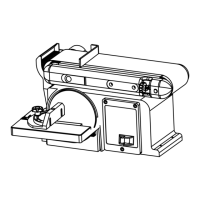Use of Extension Cords
USE ONLY THREE-WIRED EXTENSION CORDS that have 3-prong plugs and 3-holed outlets that
accept the tool’s plug. Repair or replace damaged or worn cords immediately.
Be sure your extension cord is properly wired and in good condition. Do not use damaged extension
cords. Always replace a damaged extension cord.
When using an extension cord, be sure to use one heavy enough to carry the current your product will
draw. An undersized cord will cause a drop in line voltage, resulting in loss of power and overheating.
The table below shows the correct size to use according to the cord length and the amperage draw
of the tool (specied on the nameplate). When in doubt, use the next heavier gauge. The smaller the
gauge number, the heavier the cord. (AWG = American Wire Gauge).
Minimum Gauge for Extension Cords (AWG)
(when using 120 volts only)
Ampere Rating Total Length of Cord in Feet (meters)
More Than Not more Than 25’ (7.6m) 50’ (15m) 100’ (30.4m) 150’
(45.7m)
0 6 18 16 16 14
6 10 18 16 14 12
10 12 16 16 14 12
12 16 14 12 Not Recommended
Use a separate electrical circuit for your tools. This circuit should not be less than a #12 gauge wire,
and should be protected with a 15 A time-lag fuse or breaker. Before connecting the motor to the
power line, ensure the switch is in the OFF position and the electric current is rated the same as the
current stamped on the motor’s nameplate. Running at a lower voltage will damage the motor and this
damage is not covered by warranty.
6

